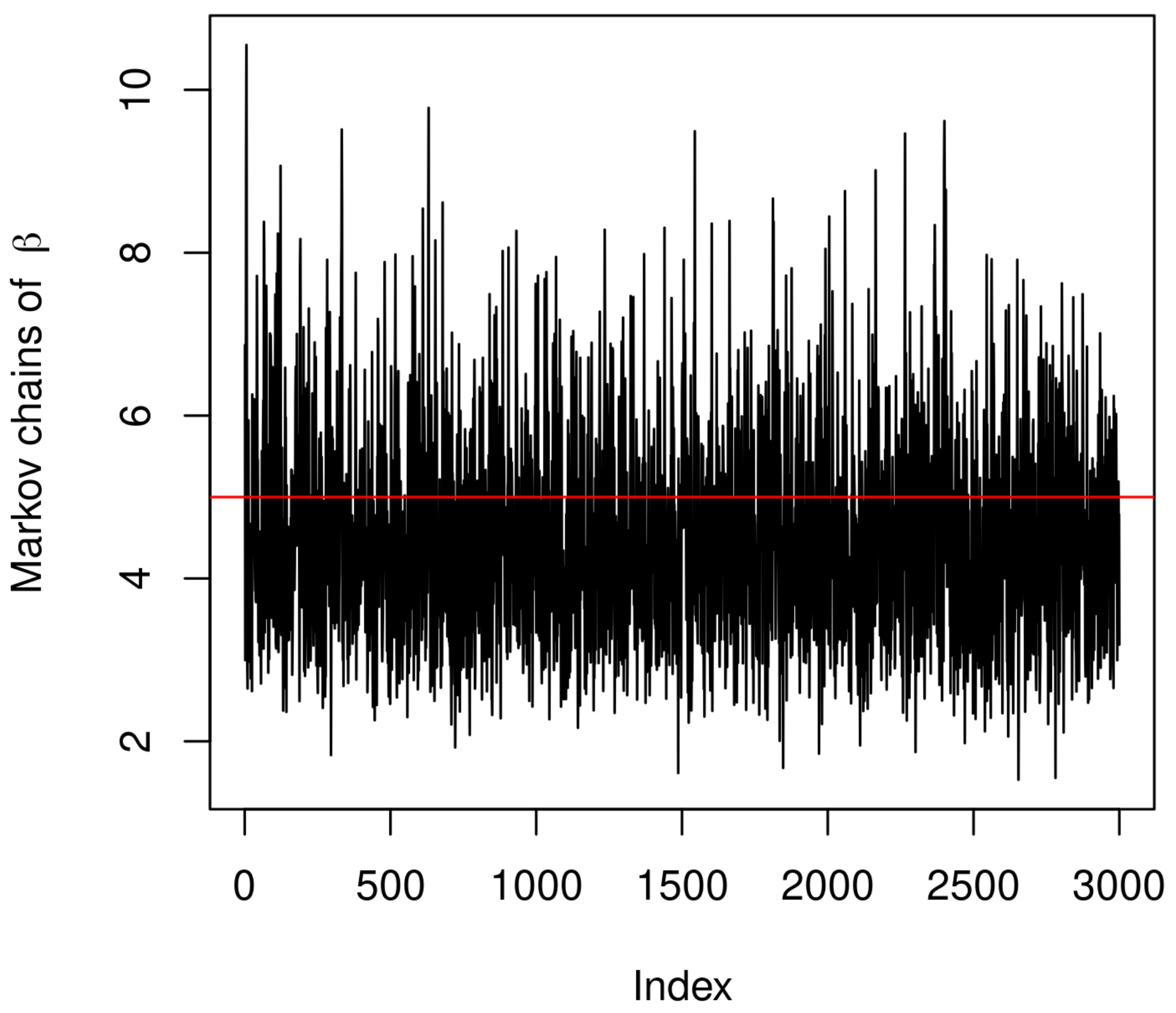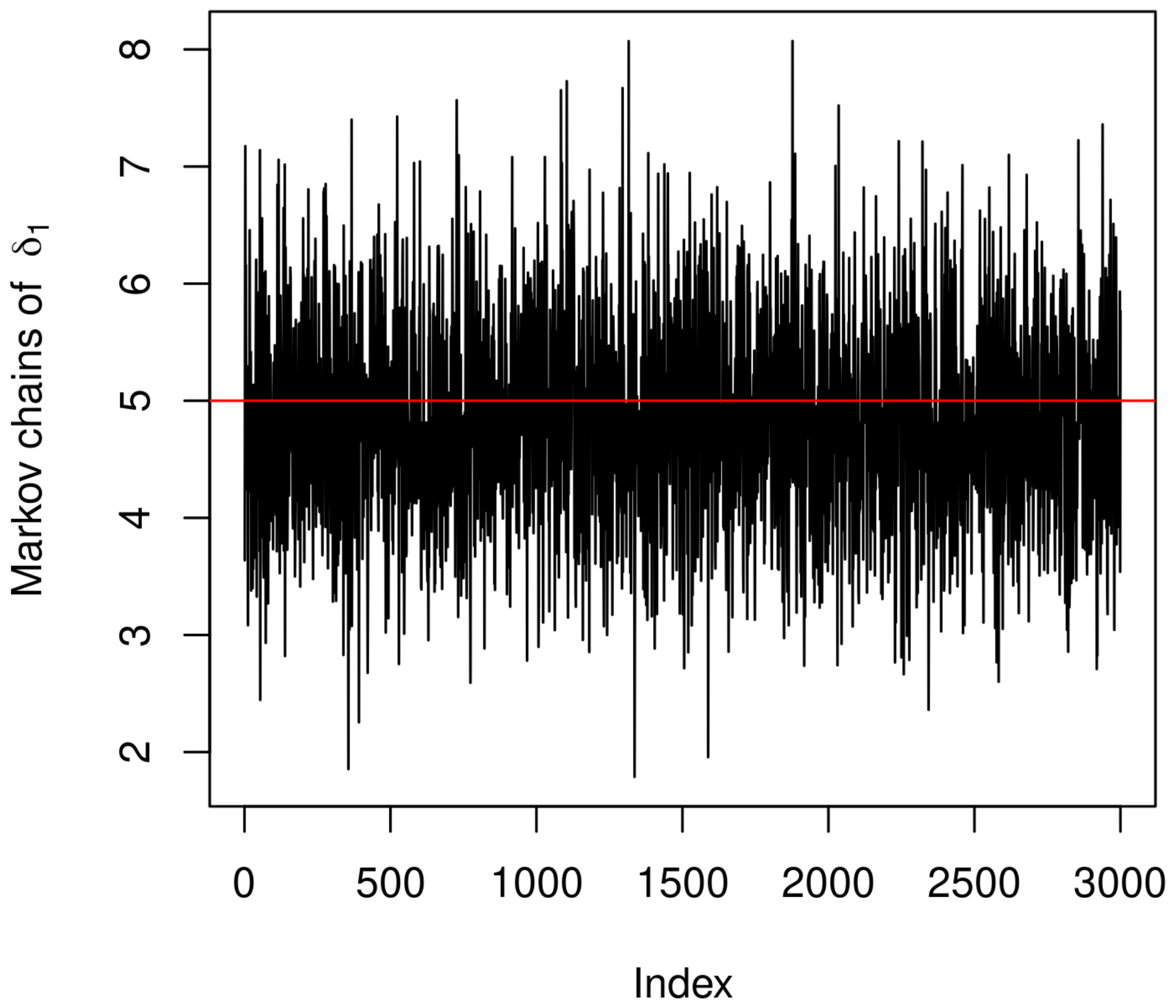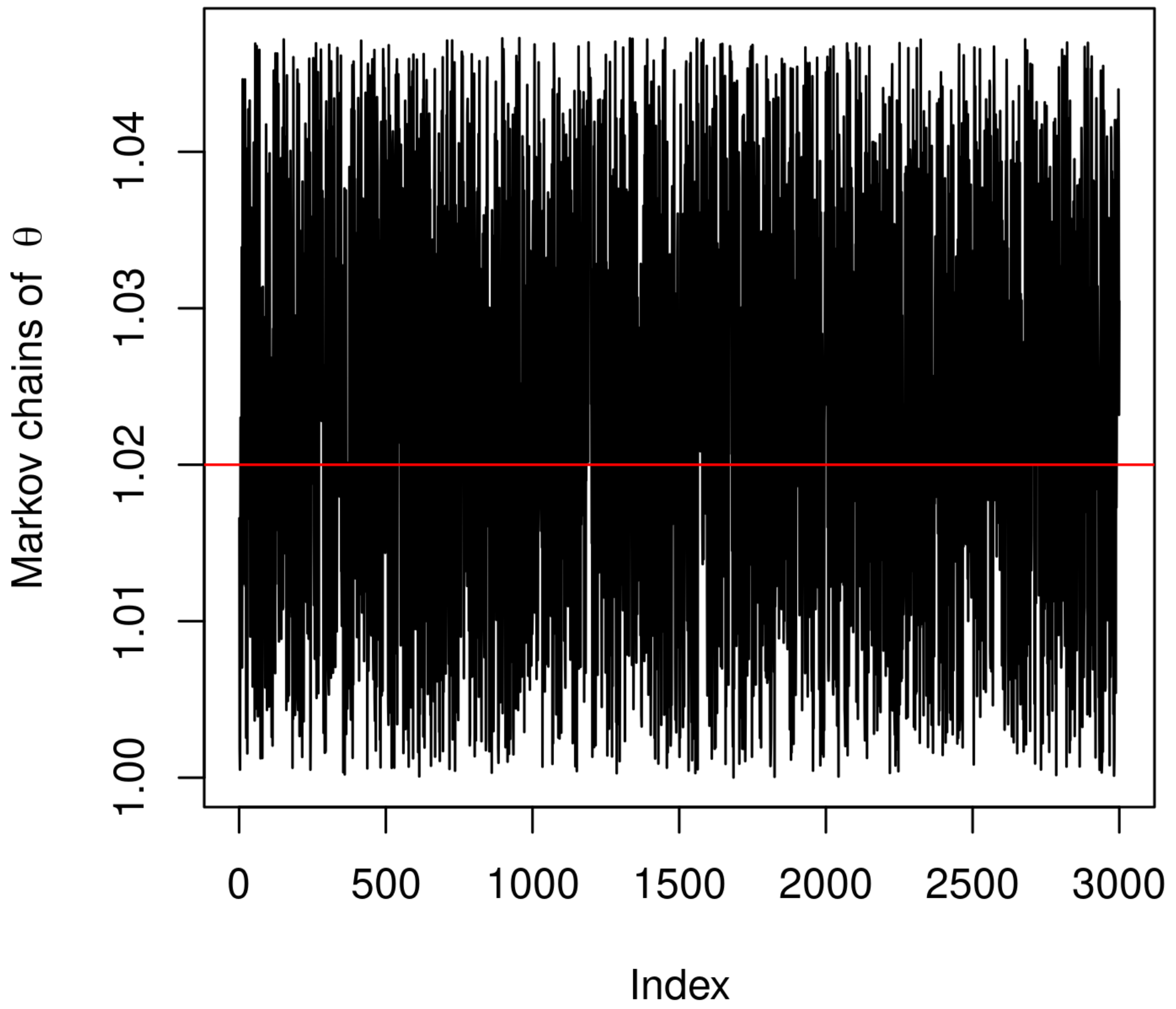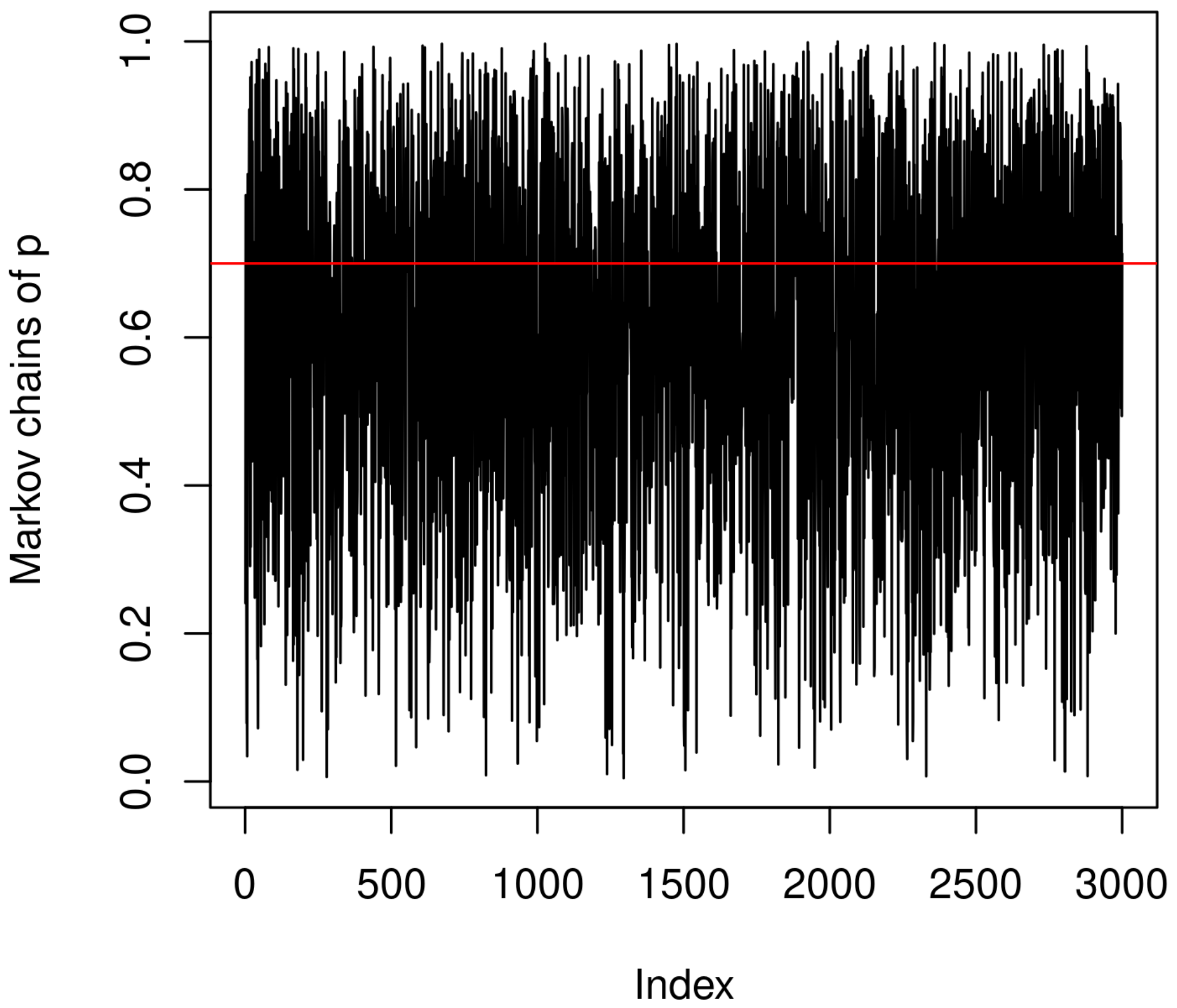2. The Lifetime Distribution and Statistical Methods
Let the CDS components from a supplier have lifetimes that follow a baseline two-parameter BXIID, whose probability density function (PDF), cumulative density function (CDF), and hazard rate function are, respectively, defined by
and
where
is scale parameter and
is the outer-shape parameter. This is a special case of three-parameter BXIID with inner-shape 1. Therefore, the survival function of each basic component is defined by
Because the three-parameter BXIID with two shape parameters could result in a model identification problem for parameter estimation, we only keep the outer-shape and scale parameters for the mixture-BXIID model in this study when dual suppliers occur. Denote the BXIID defined in Equations (
1)–(
4) by BXIID
hereafter. The format of the mixture-BXIID model for dual suppliers will be addressed later.
When all components come from a single supplier, each component failure means that the CDS equally redistributes the stress loading to all surviving components and changes their lifetime distributions. Under this situation, the lifetimes of the surviving components in the CDS follow BXIID with different hazard rates at each failure. At the
jth SOS, the PDF, CDF, and hazard rate function of the lifetimes of surviving components can be defined by
,
, and
,
, respectively, where
, for
, and
. The PTHR model proposed by Balakrishnanet et al. [
25],
is considered to model the increased hazard rate due to component failure, where
denotes the multiple of baseline hazard rate for the hazard rate after the
jth failure. The CDF corresponding to
in Equation (
5) is
for
.
When dual suppliers support the components simultaneously, the failure times of all baseline components should be modeled by the mixture-BXIID of BXIID
and BXIID
. Then, the PDF of the baseline mixture-BXIID can be addressed by
where
is the PDF of BXIID
,
;
and
. We can represent Equation (
6) by
Let
for
be the corresponding CDFs. The CDF of the mixture-BXIID can be presented by
Denote the mixture-BXIID defined by Equations (
7) and (
8) by mBXIID
hereafter.
Let
denote the realizations of the SOS sample of the first
r component failure times from the mBXIID
. The likelihood function based on the sample
can be defined by
where
,
for
and
. Using the PTHR model of
,
in Equation (
9) with
, it can be shown that
and
. Let
. The likelihood function of Equation (
9) can be represented by
and the log-likelihood function can be presented by
After straightforward algebraic computation, it can be shown that the first derivatives of
with respect to
and
p are given as follows:
where
and
Because Equations (
12)–(
16) are complicated, it is very difficult to obtain the second derivative of the log-likelihood function with respect to
,
,
,
, and
p, respectively, so as to obtain the Fisher information matrix. Therefore, it is intractable to find the asymptotical confidence intervals of the model parameters using the Fisher information matrix. In this paper, we propose a MH-GS MCMC method to obtain the Bayes estimates of the model parameters and the baseline survival function. Denote the Bayes estimators of
,
,
,
, and
p by
,
,
,
, and
, respectively. Consider the following joint prior distribution:
where
and
That is, we consider that the shape parameter is
and the scale parameters are
and
;
follows a Uniform distribution over
, denoted by
, and
. Because the PTHR function is used in this study, it can be shown that
, and
is a constant larger than but close to 1. The determination of
will be studied in
Section 3.
The posterior distribution of
, given the SOS sample
, can be obtained by
The conditional posterior PDFs of
,
,
,
, and
p can be presented by
and
respectively.
It is intractable to use the complete conditional probabilities of
,
,
,
, and
to implement the GS MCMC or IS MCMC methods. Therefore, the MH-GS MCMC method is proposed to obtain the Bayes estimates of model parameters due to the fact that the proposed MH-GS MCMC method only uses the M-H algorithm and Equations (
19)–(
23) to update the parameters in the MCMC procedure. The steps to implement the MH-GS MCMC method are presented as follows.
Method I: The MH-GS MCMC method.
Initial Step: Give arbitrary initial vales of , , , , and from the respective parameter domains; propose a transition probability function, , to generate a possible , given for ; and let .
- Step 1:
Implementing Step 2 N times, i.e., , where N is a big positive number.
- Step 2:
For
, use Step 2.1 to Step 2.5 to update
,
,
,
and
. The acceptance criterion is based on the M-H algorithm, see in [
35].
- Step 2.1:
Generate and .
If , update by ;
otherwise, .
- Step 2.2:
Generate and .
If , update by ;
otherwise, .
- Step 2.3:
Generate and .
If , update by ;
otherwise, .
- Step 2.4:
Generate and .
If , update by ;
otherwise, .
- Step 2.5:
Generate and .
If , update by ;
otherwise, .
- Step 3:
Go to Step 2 until .
- Step 4:
Denote the obtained Markov chains by
,
,
,
, and
, respectively. Based on the square error loss function, the Bayes estimator can be the sample mean of the obtained Markov chain after burn-in,
, and is denoted by
We suggest the proposed transition probability function,
, as a symmetric function about
for
to reduce computational loading. For example, Normal and Uniform distributions with means of
are two widely used transition probability functions. Based on the Markov chains of
,
,
,
, and
, we can establish the Markov chain of the baseline survival distribution
If we use a non-informative prior distribution to obtain the Bayes estimates, the major contribution of the posterior distribution comes from the likelihood function. Subsequently, the obtained Bayes estimates of the parameters are closed to the MLEs. In this study, we can select the hyperparameters such that the variances of the Gamma prior distributions of , , and are large enough to make the prior distribution non-informative. Then, the obtained Bayes estimates of parameters are closed to the MLEs. This method can overcome the possible divergence problem by using gradient methods of solving the likelihood equations of , , , , and to obtain the MLEs of the model parameters.
3. Discussions
In this section, a numerical SOS sample of
and
was generated from the baseline of mBXIID
to demonstrate the implementation of the proposed MH-GS MCMC method. The PTHR model with
is considered in this example. The scenario of this numerical example for CDS is to assume that the CDS is claimed as failure if 15 or half of the components fail; that is, the CDS is claimed as failed if half of the components in the CDS fail or the hazard rate increases to approximately
,
, from the baseline hazard rate. In order to generate a SOS sample from the mixture baseline distribution of mBXIID
, we need to generate one more random sample
from
. If
, then the
ith SOS is generated from the BXIID
; otherwise, the
ith SOS is generated from the BXIID
. The 15 generated SOSs from the mBXIID
are reported in
Table 2.
To determine the parameters of
N and
in the proposed MH-GS MCMC method for practical use, we first generate
N = 11,000 Markov chains for the MH-GS MCMC method, in which the first
1000 chains are removed for burn-in. The posterior distribution and proposals for the MH-GS MCMC method are set up as follows: the prior distribution of
defined in Equation (
17) is considered with the hyperparameters
and constant
, where
is the value when the hazard rate of CDS at the time of
rth failure increases to 2 times of the baseline hazard rate. Let the one-step-ahead parameters of
,
, and
be
,
, and
, respectively. The normal distributions of
,
,
,
and the uniform distribution
are used as proposals to generated the values of
, and
in Method I. If
, then
; if
, then
for
; and if
or
, then
.
We found that the Markov chains of
are highly correlated as their first-order autocorrelation coefficient is about 0.80, and the first-order autocorrelation coefficients of the other Markov chains of
and
p are smaller than 0.15. Therefore, we need to trim the Markov chains by spacing to reduce the autocorrelation among the Markov chains of
. To study the adequate interval length for spacing by simulations, we regenerate Markov chains of length
31,000 and remove the first
1000 chains for burn-in based on the SOS sample in
Table 2 by using the proposed MH-GS MCMC method and check the first-order autocorrelation coefficient of the Markov chains of
by spacing with the interval lengths of 1, 3, 5, 10, 15, and 20, respectively. We find that the spacing of interval length 10 can significantly reduce the first-order autocorrelation coefficient among the Markov chains of
below 0.2. Based on the simulation findings, all Markov chains are slimmed by taking one of every 10 Markov chains to reduce the autocorrelation of Markov chains.
Figure 1,
Figure 2,
Figure 3,
Figure 4 and
Figure 5 present the 3000 slimmed Markov chains of
and
p. In the scan of
Figure 1,
Figure 2,
Figure 3,
Figure 4 and
Figure 5, we find that the proposed MH-GS MCMC method performs well to obtain the Bayes estimates of the CDS model parameters. The Bayes estimates are
,
,
,
, and
. All Markov chains well cover their true parameter. All the acceptance rates are high and reported by 0.715, 0.823, 0.95, 0.708, and 0.582 for the Markov chains of
, and
p, respectively. The first-order autocorrelation coefficients are 0.192, −0.001, 0.009, −0.004, and 0.058 for the slimmed Markov chains of
, and
p, respectively. Let
, it can be shown that the baseline survival function is
for
. The Markov chains of
can be established through using the slimmed Markov chains of
and Equation (
8). The Bayes estimate of
is
.
The Markov chains of
can be used to establish the empirical distribution of
, and then the HCI and ECI of
can be obtained. Based on the SOS sample in
Table 2, the 95% HCI of
is (0.588, 0.820) and the 95% ECI of
is (0.581, 0.815). The coverage probabilities of the 95% HCI and ECI of
are evaluated using the proposed MH-GS MCMC method with 1000 iterations. We obtain coverage probabilities of 0.961 and 0.974 for the HCI and ECI of
, respectively. The simulation results indicate that the coverage probability of HCI is closer to the nominal coverage probability than the coverage probability of ECI. Therefore, the HCI outperforms the ECI for the proposed MH-GS MCMC method in terms of the coverage probability.
4. Monte Carlo Simulations
To explore the estimation quality of the proposed Bayesian estimation method using an MH-GS MCMC approach, an intensive simulation study was conducted, and the proposed Bayesian estimation method is used to obtain the Bayes estimates of the CDS model parameters based on the SOS samples. As the parameter setting in
Section 3, we consider the baseline of mBXIID
for simulations with the parameters of
, and
. The CDS is defined as failure if half or over 30 of the components fail. We are also interested to evaluate the estimation quality of the proposed Bayesian estimation method for different mixture probabilities. We use
31,000,
1000, and interval length 10 for spacing to implement the MH-GS MCMC method. Moreover, the posterior distribution of
in Equation (
18) with the hyperparameters
and constant
is used to obtain the Bayes estimates of the model parameters, where
is the value when the hazard rate of CDS at the time of
rth failure increases to 2 times of the baseline hazard rate. The proposals of
,
,
,
, and
are used to generated the values of
and
in Method I. If
, then
; if
, then
for
; and if
or
, then
.
We repeat the proposed Bayesian estimation method 10,000 times to obtain 10,000 Bayes estimates of
and
p, then the 10,000 Bayes estimates are used to evaluate the bias and MSE for each Bayes estimate. Because the scales of the parameters are different, we use relative bias and relative square root of MSE, which are free of the scale, as the performance measures to study the estimation quality of the proposed Bayesian estimation method. The relative bias stands for the bias over the true parameter, and the relative square root of MSE stands for the square root of MSE over the true parameter. We use rBias and rsqMSE to denote the relative bias and relative square root of MSE for simplicity hereafter. All simulation results based on the proposed Bayesian estimation method are reported in
Table 3,
Table 4 and
Table 5.
In order to compare the estimation performance of the proposed Bayesian estimation method with the maximum likelihood estimation method, the MLEs of
, and
p are also obtained and denoted by
, and
, respectively. Moreover, the rBias and rsqMSE of each MLE are evaluated based on 10,000 obtained MLEs. Because there is a high probability that the gradient methods cannot successfully solve log-likelihood equations to obtain the MLEs of model parameters, we use the proposed Bayesian estimation method with a non-informative prior distribution to obtain approximate MLEs. Let
and
in Equation (
17) to make the Gamma distributions of
,
, and
have a big variance, and then the prior distribution of Equation (
17) becomes non-informative. All simulation results based on the maximum likelihood estimation method are reported in
Table 6,
Table 7 and
Table 8. In view of
Table 3,
Table 4,
Table 5,
Table 6,
Table 7 and
Table 8, we find the following results.
The Bayes estimates in
Table 3,
Table 4 and
Table 5 are more reliable and outperform the MLEs in
Table 5,
Table 6 and
Table 7 in terms of the measures of bias and MSE. The rBias and rsqMSE of the Bayes estimate are smaller than the rBias and rsqMSE of MLE.
The estimation results in
Table 3,
Table 4 and
Table 5 indicate that the estimation quality of the Bayes estimate for the mixture proportion is worse than the estimation quality of the Bayes estimates for other parameters. Moreover, the censoring rate significantly influences the estimation quality of Bayes estimates.
The maximum likelihood estimation method is less reliable for estimating the mixture proportion and shape parameter. Moreover, the acceptance rate is low for the Markov chains of the parameters of
and
p if non-informative prior is used to implement the Bayesian estimation methods. The rBias and rsqMSE of the MLEs of
and
p in
Table 6,
Table 7 and
Table 8 are large even when the sample size increases to 100 or the censoring rate is high. The findings mean that it could fail to use the maximum likelihood estimation method to obtain reliable estimates of the model parameters if the component lifetimes in CDS follow a baseline mixture distribution.
5. Conclusions
In this study, we proposed a maximum likelihood estimation method and a Bayesian estimation procedure using the MH-GS MCMC approach to obtain reliable Bayes estimators of the CDS model parameters and baseline survival function based on SOS samples when the component lifetimes follow the baseline of mixture-BXIID. The PTHR function is used to characterize the increased system hazard caused by component failures. For each component failure, the stress loading can be equally redistributed to the surviving components in the CDS. The proposed methods include the Bayesian estimation for a single baseline of BXIID for CDS as special case when .
The implementation of the proposed Bayesian estimation method with the MH-GS MCMC approach is presented systematically in Method I. The proposed Bayesian estimation method is studied by utilizing a numerical example. An intensive simulation study is conducted to evaluate the performance of the proposed Bayesian estimation method and the maximum likelihood estimation method. Based on the simulation results in
Section 4, we find that the proposed Bayesian estimation method outperforms the maximum likelihood estimation method to obtain reliable estimates of the CDS model parameters and its baseline survival function in terms of the relative bias and MSE.
The maximum likelihood estimation method does not perform well in obtaining reliable MLEs of the shape parameter and mixture proportion, and it is also intractable to obtain the Fisher information matrix to construct an approximate confidence interval for the baseline survival function of mixture-BXIID. Therefore, one major contribution of this study is to propose a simple Bayesian estimation method to overcome the divergence problem of the typical maximum likelihood estimation method to obtain approximate MLEs using a non-informative prior distribution. Moreover, the proposed HCI and ECI methods based on using the Markov chains of the baseline survival function can help practitioners to carry out interval inference for the baseline survival function.
The simulation results in
Section 4 also show that the estimation quality of the Bayes estimate for the mixture proportion is worse than the estimation quality of the Bayes estimates for other parameters. Moreover, the censoring rate significantly influences the estimation quality of Bayes estimates. When the censoring rate is low, the rBias and rsqMSE of the Bayes estimate could be less stable and fail to decrease along the sample size. There is also room to improve the estimation quality of using the proposed Bayesian estimation method to estimate the shape parameter of the mixture-BXIID. It is also important to extend the proposed Bayesian estimation method to other mixture distributions. These topics can be studied in the future.












